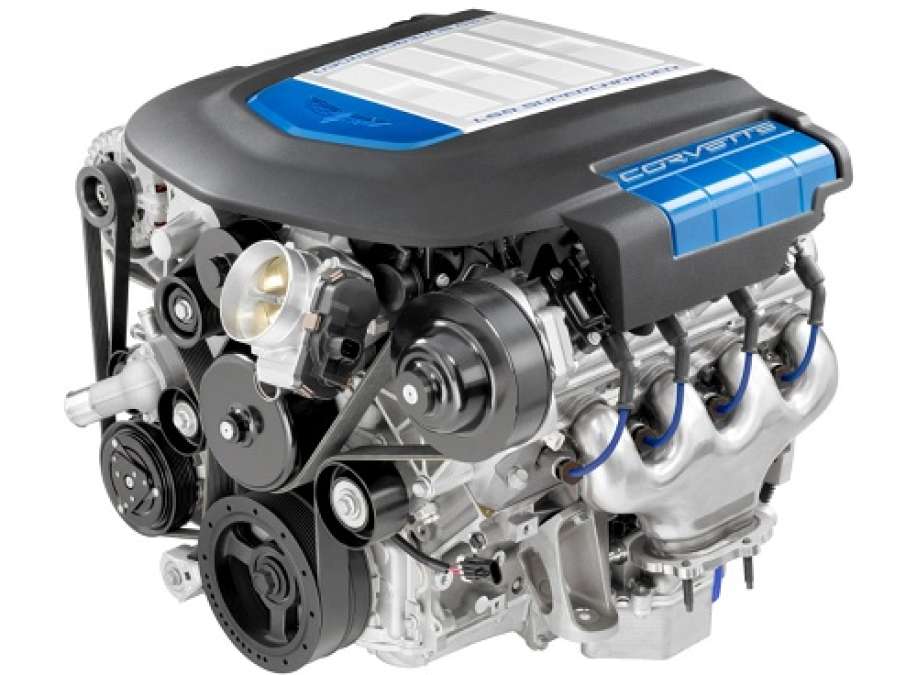The 2013 Chevrolet Corvette ZR1 features a 6.2 liter engine with a supercharger that compresses and rams fuel and air into the beast. It is literally one of the largest gasoline engines that can be found in a passenger car and has well over 600 hp. This V8 is state of the art in many ways, and yet, it is one of the oldest engine designs on the market as well.
In 1955 Chevy introduced an engine that had 8 cylinders, used push-rods to actuate the cylinders (being pushed up from the camshaft located at the bottom of the engine, the valves being on top) and had a bore spacing of 4.4 inches between cylinder centers. The reason the name “Small block” was adopted, was that this engine design made the machine about as compact as it could be. The displacement of the engine could be varied by changing both the width of the cylinder bore and also by changing the “Stroke” or length of travel up and down inside the cylinder by the pistons. This made the engine extremely flexible in terms of design. In 1955 the displacement was 4.3 liters and the engine produced a respectable 195 horsepower. 99% of buyers of Corvettes opted for it over the V6.
In 2013 the Corvette still has 4.4 in bore centers, still has a 90 degree V design and 8 cylinders. It still uses pushrods to move the valves even though almost every single competitor now uses dual overhead cams to actuate the valves. In its 430 hp version, known as the LS3, the Corvette presently generates 430 hp. This basic V8 with its old technology and its huge size must be a terrible fuel hog, right? Wrong. The Corvette with this engine achieves 26 mpg, just a tad better than a Subaru Outback V6. Many car companies (including Chevy ironically) continue to claim that small turbo-charged engines can produce the same power and deliver better fuel economy in a given car class. Let’s look at some performance cars and compare. Take for example the Porsche 911 Turbo. With its 6 cylinders and turbocharged engine it must deliver better fuel economy than the old design of the Corvette, right? Nope, it only gets 24 highway. What about the Nissan 370Z with its normally aspirated (non-turbo) V6? Surely it can beat the corvette’s monster V8 in terms of efficiency? Nope, slower and it can only tie the Corvette. The same is true of the BMW Z4 with its “little” 3.0 liter in-line 6 cylinder engine.
Every engineer knows that there a lot of factors that go into a successful, efficient, design. If only the folks in the marketing department could understand. It is so much easier to simply say “Smaller, turbocharger, better.”






Comments
In 1955 there was no "V6"
Permalink
In 1955 there was no "V6" engine. The engine was a straight in-line 6. Also, there is a lot more to fuel economy than engine size. Add a overdrive tranmission (or double overdrive) can add double digit percentage gains in fuel economy. Reducing engine speed which the Corvette does, reduces consumption providing the engine can pull the car at speed (not problem with 430 horsepower on tap). Of course all this comes with reduced immediate performance for any given speed. Some of the engines you mention are in cars more concerned with immediate performance than fuel economy.
Thanks for reading! You may
Permalink
In reply to In 1955 there was no "V6" by Bluephrog (not verified)
Thanks for reading! You may know better, but here is Chevy's statement from their media website on the Corvette:::::"Despite a sporty appearance, the early Corvettes’ performance didn’t match their good looks. The car launched in 1953 with the “Blue Flame” inline six-cylinder engine and a two-speed automatic transmission – not exactly the stuff on which to build a sports car legend. That changed in 1955, when the new small-block V-8 engine became available and was ordered by 99 percent of Corvette buyers."
Are you saysing you don't
Permalink
In reply to Thanks for reading! You may by John Goreham
Are you saysing you don't know the difference between an in-line 6 and a V6? To gearheads that is a major difference.
I think the confusion is over
Permalink
In reply to Thanks for reading! You may by John Goreham
I think the confusion is over a typo in your second paragraph which says "opted for it over the V6." and probably should say "straight six" instead.
I was just in the new 2013
Permalink
I was just in the new 2013 GMC Acadia and Terrain yesterday, by the way, and these SUVs have a larger 3.6L V6 option that replaces the older 3.0L, but keeps the same fuel economy despite the extra displacement and output. This is mainly due to the better SIDI on the Ecotec and the new-generation VVT mated with it.